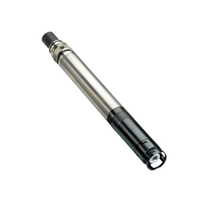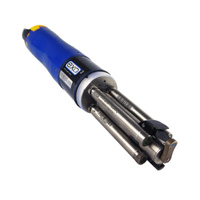Nitrates enter waterways as runoff from cropland and fertilized lawns, discharged from wastewater treatment plants, as runoff from areas where animal manure is stored, from failing on-site septic systems, and as it is discharged in the effluent from industrial sites. Ultimately, the result can be hypoxic dead zones and die-offs of various species—not to mention undrinkable water, as high enough nitrate levels in water are toxic to warm-blooded animals. Monitoring and tracking nitrate concentrations are crucial due to the serious effects on water quality,
Real-Time Nutrient Monitoring
Monitoring and tracking nitrate concentrations is essential for answering the management and science questions of lake managers, riverkeepers, and other water quality professionals. This nutrient data helps managers assess how effective nitrogen removal efforts are, and allows them to refine nutrient loading models. Nitrate sensors and the real-time data on nitrate concentrations they produce can help us provide safe drinking water, manage wastewater discharge safely, track and identify sources of nitrate to estuaries and streams, understand how nitrates are transported through watersheds and evaluate the effectiveness of water quality-related land-management practices.
In some settings, a management team will collect discrete grab samples for lab analysis to measure nitrate levels. However, manual collection efforts are typically more costly, and provide less data—and can pose a safety risk for personnel. Additionally, depending on the weather, the sampling location, and other issues, it may be difficult for a manual sampler to ensure accurate measurements.
For these reasons, real-time nutrient monitoring systems offer a much more complete, reliable, and feasible means of nitrate data collection. Continuous nutrient loading data allows for the quantification of even smaller, short-term events that are easy to miss with even the most diligent manual sampling techniques.
Real-time sensors also provide more temporal and spatial insight into hydrologic systems. Real-time nitrate data can immediately signal a need for additional drinking water treatment, provide more accurate details on nitrate loads and concentrations at intake points, and can help identify sources and focus remediation activities based on established priorities.
Nutrient Monitoring Technology
Ion selective electrode-based sensors enable real-time monitoring for nitrate. Used in conjunction with a meter, a nitrate electrode works much like a dissolved oxygen meter does. The nitrate electrode is a probe with a sensor. Inside the probe is a solution, and the device calculates nitrate activity in the water by measuring how that nitrate activity affects the electric potential of that solution.
Fluctuating pH levels and high concentrations of bicarbonate or chloride ions in the sample water can negatively affect the accuracy of the electrode or the meter reading. Overall, however, this is the cheapest way to monitor for nitrate in real-time with a large range, and good reliability.
Some instruments monitor nitrate continuously using wet chemistry in-situ. These sensors offer high accuracy, precision, and resolution, and can also detect ammonium, orthophosphate and silica. They also boast a fairly quick response time and make in-situ calibrations possible. However, these are far more expensive than the electrode-based sensors and demand high levels of power, maintenance and vigilance against fouling.
Finally, optical (UV) sensors can detect nitrogen levels based on the fact that nitrate ions absorb ultraviolet (UV) light at wavelengths less than 220 nanometers (nm). These sensors offer high accuracy, precision, and resolution, as well as a large measurement range. They operate without chemical reagents, work quickly, and have some inherent protection against fouling. However, they are the costliest of the nitrate sensors, can detect only nitrate and nitrite, require a lot of power and maintenance and are vulnerable to optical interferences.
Typical Nitrate Nutrient Monitoring Package
Nitrate sensors don’t always get deployed alone. They are often deployed with multi-parameter sondes alongside other water quality probes and sensors. Nitrate sensors are frequently used in tandem with probes that measure dissolved oxygen, pH, salinity, specific conductivity, temperature and turbidity. Additionally, velocity and/or stage sensors can assist those interpreting the data to better correlate nitrate loading and hydrologic conditions.
All sensors, including nitrate electrodes, can be integrated with data loggers. These data loggers, which make use of real-time telemetry, support cellular, radio, and Iridium satellite communication packages. This means that your field data gets transmitted automatically and regularly to a base station computer that can interface with the data loggers, and you always have access to the data when you need it.
Selecting the Right Nutrient Monitoring System
Which nutrient monitoring system is right for your problem depends on various factors. There are differences between systems in cost, field maintenance requirements, and power consumption.
The specific goal of the user is also important. What is the history of the waterway—is the research question related to oceanography or wastewater treatment? What fouling issues are present? How often will someone maintain the unit?
The Bottom Line
Nutrient monitoring for nitrate is a critical function for many in water quality and management. Fortunately, the technologies available to us today make the task easier.
Real-time nutrient monitoring offers a level of insight into science and management questions that discrete sampling simply cannot rival. At NexSens, we take pride in the fact that we enable clients to do and learn more. Find out more about nutrient monitoring for nitrate here, or contact us to learn how to create the right monitoring system to meet your needs.
Equipment
The EXO guarded nitrate sensor measures NO3 in freshwater applications up to 17 meters.
EXO3 is a purpose-built sonde for monitoring major water quality parameters, including: pH, conductivity, temperature, turbidity and dissolved oxygen.
WQData LIVE is a web-based project management service that allows users 24/7 instant access to data collected from remote telemetry systems.





0 comments